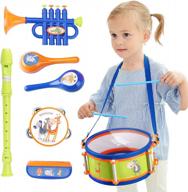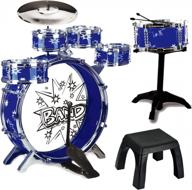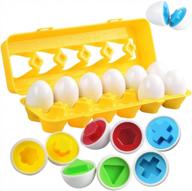
Review on 37 Key Kids Piano Keyboard With Microphone - Perfect For 3-8 Year Olds! | APerfectLife by Travis Garron

Cute, kind of charming, but musically defective!
Just got it today. It's cute and kind of charming, but it plays many chords incorrectly. This explanation may require a bit of musical theory knowledge of chords, but I'll summarize it here and give a fuller explanation in later paragraphs.Here's the problem - play a major chord in the root position (1-3-5) - it plays correctly. Play a major chord in the first inversion (3-5-1) - it adds a minor 10th (3-5-1-b10). Play a major chord in the second inversion (5-1-3) - it plays correctly.For the minor chords, it does something similar, but messes up the second inversion instead of the first inversion.Will a three-year-old who's not a Mozart prodigy care? Probably not. The harmony issues are a little advanced for someone more likely to be drawn to the frog, bird, duck, and dog sounds.But, here's why it matters to a musician or someone wanting to use this as a convenient study tool:We have a full-size acoustic upright piano. My wife plays well, but only by reading notation on the staff. She does not yet improvise and is beginning to learn more about music theory - particularly chords and inversions. She wanted a small keyboard she could play at the kitchen counter with the idea of using it to learn and practice chord inversions without sitting at the full-size piano. Once she had that knowledge, she planned to save the keyboard and give it to our young grandson when he's a little older.But when I started testing the keyboard, I ran through the inversions and realized that something was seriously wrong with the sounds. If you are familiar with the notes of a piano keyboard but not so familiar with the numeric notation above, here's how it works on this keyboard:The C major chord has the notes C, E, and G. If you play those notes in order from left-to-right on the keyboard, and hold them down together, you are playing the C major chord in root position. If you then hold down E, G, and C from left-to-right, you are playing the C major chord in the first inversion. In this inversion the E and G are in the same place as when you played in root position, but in the first inversion the C note is played an octave above the C in root position. BUT - if you do this on this keyboard, it adds an additional note to the three you are holding down. In this case, it adds the Eb above the C you are playing. So you are hearing E, G, C, Eb. It's no longer a C major chord. Like I said above, it mangles the second inversion of a minor chord, too.Since hearing what you are playing is part of learning about the keys you are playing, this is not a practical way to use this device. On another note (heh-heh), at first I though it might be fun to bring it along to a campfire jam and play a few chords along with the guitars and mandolins and so forth. Not now. (Unless I want to use if for well-timed duck quacks and such!)Too bad, since so many other aspects are pretty decent. It has 8 rhythm patterns with a tempo control. It would be neat to be able to practice chord progressions along with the beats, but you'd have to give up a third of your three-note chord options.Anyway, our grandson is still too young for this, so this one will be returned.
- Kids loved!!
- Easily scratchable surface
New products
Comments (0)
Top products in 🎼 Kids' Musical Instruments

Wooden Percussion Instruments Toy Set - Educational Musical Toys For Kids, Babies & Toddlers With Storage Bag

43 Review

Natural Wooden Percussion Instruments Toy Set For Toddlers - Educational Musical Toys With Storage Bag For Boys And Girls By LOOIKOOS

40 Review

IPlay, ILearn Toddler Musical Instruments Toys, Kids Drum Set, Baby Trumpet, Percussion, Harmonica, Maraca, Flute, Tambourine, Birthday Gifts For 18 Months Olds Ages 2 3 4 5 Years Boys Girls Children

43 Review

ToyVelt 12 Piece Kids Jazz Drum Set - Stimulate Creativity & Rock Out With Little Rockstar Kit!

41 Review
Another interesting products

School Bus Busy Board Activity Set For Early Learning And Fine Motor Development - 12 Basic Skills To Learn To Dress And Play, Ideal Sensory Toy For Preschool Kids, Kindergarten And Travel

31 Review

MINIBEAR Kids Digital Camera: 40MP, 2.4 Inch Screen, 32GB TF Card - Instant Prints & Selfies For Girls!

40 Review

Educational Learning Games Buzzer With 5 Color Push Buttons - Great Tool For Activity Transitions And Game Show Zingers Attention Bell Answer Buzzers.

37 Review

CPSYUB Montessori Matching Eggs: Educational Learning Toys For 1-3 Year Old Boys And Girls With Color & Shape Recognition Skills; BPA-Free Easter Eggs Gifts (Set Of 12 Toddler Toys)

33 Review

